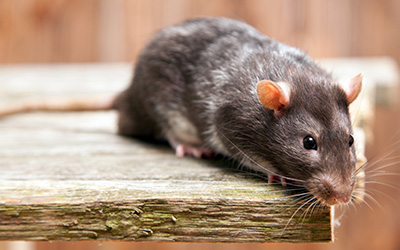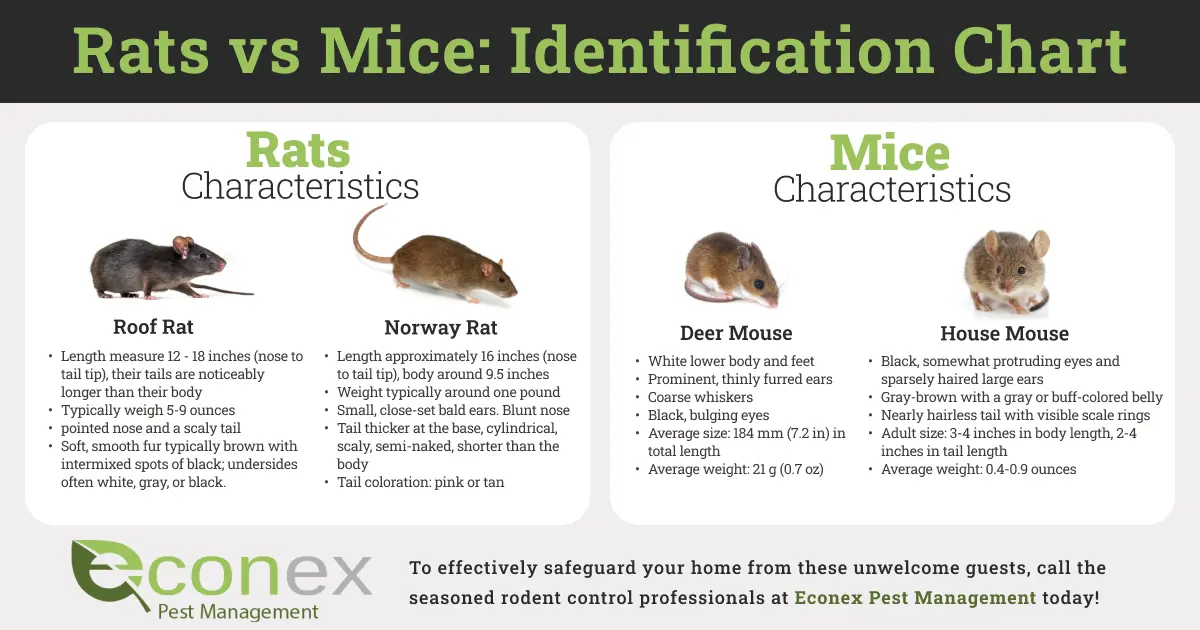
Living with rodents in your Anaheim home can be a challenging and unsettling experience. The pitter-patter of tiny feet in the walls, mysterious droppings, and chewed-up belongings can leave you wondering whether you’re dealing with mice or rats. In Anaheim, homeowners frequently encounter house mice and Norway rats, two of the state’s most common rodents. Understanding these differences is essential for effective pest control and ensuring a healthy living environment.
Rats vs Mice

Mice Characteristics
The common house mouse might seem harmless at first glance, but these small rodents can cause significant damage and pose health risks in your home. Their characteristics are:
- Typically measuring between 2 ¾ to 4 inches in length, excluding their tail.
- Slender body covered in soft, short fur, which can range in color from light brown to gray.
- Large round ears and a pointed snout
- Excellent climbers and can jump up to a foot high, allowing them to access various parts of your home.
- Prolific breeders, with a single pair capable of producing dozens of offspring in a year.
- Omnivores, feed on grains, seeds, fruits, and even small insects. They are particularly attracted to sweet foods.
Rat Characteristics
Rats are notorious intruders that can wreak havoc in our homes and spread disease. Characteristics of rats such as the Norway Rat and Roof Rat are:
- Larger than mice, measuring between 7 to 10 inches in length, excluding their tail.
- Robust, cylindrical body covered in coarse fur, which can range in color from brown and gray to black.
- Large, rounded ears and a blunt snout
- Excellent climbers and swimmers, enabling them to access various parts of your home.
- Sharp, continuously growing incisor teeth, leading them to gnaw on – and through – a wide range of materials including hard plastics and metal.
- Nocturnal creatures, primarily active during the night and preferring dark, secluded places for nesting.
- Omnivores, consuming grains, fruits, vegetables, and even meat.
Need Rodent Control Service?
Signs of Mice
Discovering signs of House Mouse and Deer Mouse in your home can be alarming, but being able to recognize these indicators is the first step toward effective pest control. Here’s what to look for:
- Droppings: Mouse droppings are small, resembling dark grains of rice. They are typically found in hidden areas such as cabinets, drawers, and along baseboards. Rat droppings are larger than those of mice, approximately the size of a raisin, and have blunt ends. Finding these droppings in hidden areas or near food sources suggests rat presence.
- Gnaw Marks: Mice and rats have strong teeth that grow continuously, leading them to gnaw on various objects. Look for gnaw marks on food packaging, wires, furniture, and even walls.
- Grease Marks: Rats often leave grease marks on walls and surfaces as they travel along their regular paths. These marks are dark and greasy and can be a clear indication of rat movement.
- Urine Odor: Mice and rats urinate frequently, leaving a distinct, musky smell in affected areas, especially in enclosed spaces like closets or cabinets. Rat urine will more likely be found in crawl spaces, attics, or basements.
- Scratching Sounds: Mice and rats are nocturnal creatures and are often heard scratching and scurrying within walls or ceilings, particularly during the night.
How to Prevent Rodents in Anaheim Homes
People residing in urban, suburban, and rural settings often underestimate the abundance of food and shelter their homes offer to rodents. Even small spills and crumbs can become a feast for rats and mice inside your house. Homeowners must be proactive and prevent these pests from infiltrating their homes due to the potential health risks associated with rodents carrying contagious diseases. To effectively safeguard your home from these unwelcome guests, call the seasoned rodent control professionals at Econex Pest Management today!
Back to Rodent Exterminators – Rat & Mice Control
